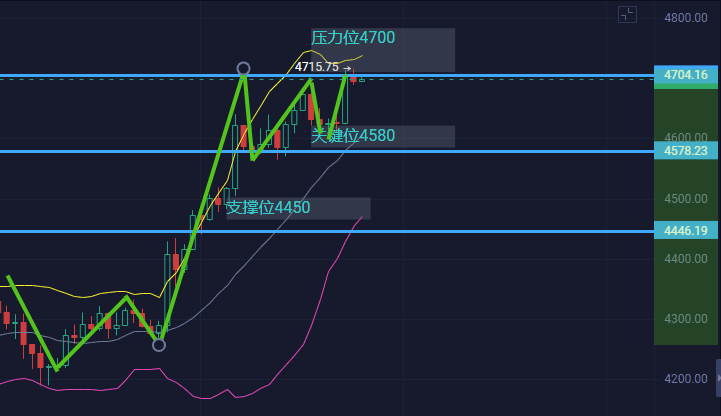'The market is like a chess game, key points determine life and death.' Today, Ethereum is repeatedly tugging at the 4700 USD barrier. This 'pressure wall' not only tests the confidence of the bulls but also serves as a touchstone to gauge the quality of this bull market.
The Game Behind the Data: Institutional Buying vs. Selling Pressure.
As of 17:56, ETH is priced at 4691 USD, up 7% in 24 hours, but there are still sell orders for 120,000 ETH at the 4700 USD level, equivalent to 450 million USD in pressure. Interestingly, the buy order thickness below is only a third of the sell order, indicating that chasing funds are cautious — this contrasts sharply with institutional actions:
BlackRock and others are 'voting with real money': During the first week, the three US ETH spot ETFs saw a net inflow of 830 million USD, with BlackRock's holdings exceeding 832,000 units and Fidelity buying 470 million USD in a single week.
Technological upgrades ignite institutional enthusiasm: After the Pectra upgrade, Arbitrum Nova's daily transaction volume exceeded 120 million, with 68% of the 80 billion USD in DeFi locked being ETH staking, and the cost reduction effect of Layer 2 directly translates into ecological prosperity.
Breaking Down the 'Triple Gate' of 4700.

Technical Analysis: Golden Cross vs. Overbought.
The MACD histogram has turned positive, with MA10 crossing above MA30 forming a golden cross, but the RSI over 70 indicates short-term overbought conditions. If it stabilizes above 4580 USD, the bulls will challenge the previous high of 4757 USD; if it breaks down, the iron bottom at 4450 USD may be tested.Capital Flow: ETF Inflows vs. Unlocking Wave.
In August, nearly 3 billion USD worth of tokens were unlocked, but the ETH ETFs attracted over 1 billion USD in a single week, with institutional funds hedging against the unlocking pressure.Interconnectivity: BTC Dragging vs. SOL Stealing the Show.
BTC only increased by 0.31% today; if it continues to be weak, it may drag down ETH; while SOL surged by 11.78%, showing a clear capital rotation effect — if ETH fails to break through after a prolonged attack, some hot money may shift to the 'speed players' SOL.
Qing Yao's Viewpoint: Why is 4700 the 'Bull-Bear Boundary'?
From the perspective of wave theory, ETH is in the main upward phase of the third wave, with 4580 USD being a key resistance level. Once broken, the target for the fifth wave points directly to 4525-6190 USD. But the more core logic is:
Institutionalization Dividend: After the ETH ETF approval, the intensity of institutional capital inflow reached three times that of BTC, with traditional giants confirming their 'digital gold' status with real money.
Ecological Monopoly: 52% of stablecoins and 73% of US treasury tokenization choose Ethereum, creating a positive cycle of 'asset locking - ETH burning' on the RWA blockchain.
Technical Lag: Solana may be fast, but it has experienced multiple outages; Ethereum's Layer 2 modular expansion has attracted over 200 DApps to migrate, achieving both cost reduction and security.
Qing Yao's Strategy: Three Steps to Respond to 'Spike Market'.
Key Level Game: 4580 USD set as the observation line, if stabilized, can lightly test the long position targeting 4757 USD; if broken, reduce positions to around 4450 USD.
Hedging Strategy: Allocate 5% in stablecoins to guard against SEC staking review risks; increase positions in Layer 2 leaders when the ETH/BTC exchange rate breaks 0.02.
Beware of 'Midnight Raids': Recently, volatility has surged, and the main force may create 'spike' markets during US stock closing periods, requiring dynamic adjustment of stop-loss levels.
Next Stop, 6000 USD?
Under the triple resonance of technological upgrades, institutional buying, and ecological explosion, ETH breaking through 4700 USD is just the starting point. But what’s worth contemplating is: when Layer 2 resolves the expansion pain points, when the tokenization of RWA exceeds a trillion, when the ETH staking rate reaches 40%, will 6000 USD be the endpoint?